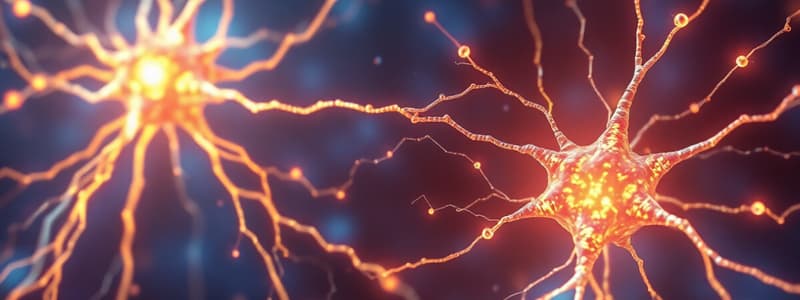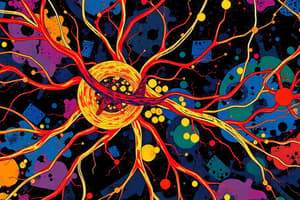Podcast
Questions and Answers
How does the location of a synapse on a post-synaptic neuron (e.g., axo-dendritic vs. axo-somatic) influence the neuron's likelihood of firing an action potential?
How does the location of a synapse on a post-synaptic neuron (e.g., axo-dendritic vs. axo-somatic) influence the neuron's likelihood of firing an action potential?
Synapses closer to the soma, such as axo-somatic synapses, have a greater influence on the neuron's likelihood of firing an action potential because the signal doesn't have to travel as far to reach the axon hillock, where action potentials are initiated.
Describe a scenario where an axo-axonic synapse might play a crucial role in regulating neural communication.
Describe a scenario where an axo-axonic synapse might play a crucial role in regulating neural communication.
An axo-axonic synapse could regulate the amount of neurotransmitter released by the post-synaptic axon. For example, it could inhibit neurotransmitter release to fine-tune the signal.
What are the key structural distinctions between electrical and chemical synapses, and how do these differences relate to their respective speeds of transmission?
What are the key structural distinctions between electrical and chemical synapses, and how do these differences relate to their respective speeds of transmission?
Electrical synapses have gap junctions, allowing direct ion flow and rapid transmission. Chemical synapses have a synaptic cleft, requiring neurotransmitter release and diffusion, making them slower.
In the context of neural networks, why might dendro-dendritic synapses be important for creating local circuits with specific functions?
In the context of neural networks, why might dendro-dendritic synapses be important for creating local circuits with specific functions?
Compare and contrast the advantages and disadvantages of electrical versus chemical synapses in the nervous system.
Compare and contrast the advantages and disadvantages of electrical versus chemical synapses in the nervous system.
If a drug selectively blocked gap junctions, what specific effect would this have on neural transmission, and which type of synapse would be most affected?
If a drug selectively blocked gap junctions, what specific effect would this have on neural transmission, and which type of synapse would be most affected?
How could you experimentally determine whether a particular synapse is electrical or chemical, assuming you have the ability to measure the speed of transmission and the presence of neurotransmitters?
How could you experimentally determine whether a particular synapse is electrical or chemical, assuming you have the ability to measure the speed of transmission and the presence of neurotransmitters?
Explain how the anatomical structure of a synapse relates to its function in signal transmission. Consider both electrical and chemical synapses.
Explain how the anatomical structure of a synapse relates to its function in signal transmission. Consider both electrical and chemical synapses.
Describe the sequence of events that occur at a chemical synapse from the arrival of an action potential at the pre-synaptic terminal to the generation of a post-synaptic potential.
Describe the sequence of events that occur at a chemical synapse from the arrival of an action potential at the pre-synaptic terminal to the generation of a post-synaptic potential.
If a neuron simultaneously receives both excitatory axo-dendritic and inhibitory axo-somatic inputs, how does the location of these synapses relative to the axon hillock affect the likelihood of the neuron firing an action potential?
If a neuron simultaneously receives both excitatory axo-dendritic and inhibitory axo-somatic inputs, how does the location of these synapses relative to the axon hillock affect the likelihood of the neuron firing an action potential?
Flashcards
Synapse
Synapse
A junction that allows neurons to communicate with each other.
Anatomical Classification of Synapses
Anatomical Classification of Synapses
Classification of synapses based on the location where the axon of one neuron connects to another.
Axo-dendritic Synapse
Axo-dendritic Synapse
A synapse where a presynaptic axon connects to a postsynaptic dendrite.
Axo-somatic Synapse
Axo-somatic Synapse
Signup and view all the flashcards
Axo-axonic Synapse
Axo-axonic Synapse
Signup and view all the flashcards
Dendro-dendritic Synapse
Dendro-dendritic Synapse
Signup and view all the flashcards
Functional Classification of Synapses
Functional Classification of Synapses
Signup and view all the flashcards
Electrical Synapse
Electrical Synapse
Signup and view all the flashcards
Study Notes
- Synapses allow neurons to communicate.
Anatomical Classification of Synapses
- Synapses are classified into three types: anatomical, functional.
- Anatomical classification depends on the ending of the axon.
- There are six types based on axon ending.
- Axo-dendritic synapse: pre-synaptic neuron synapses with a dendrite of post-synaptic neuron
- Axo-somatic synapse: axon synapses with the soma (cell body) of another neuron.
- Axo-axonic synapse: rare type, synapse occurs between axons.
- Dendro-dendritic synapse: synapse occurs between dendrites.
Functional Classification of Synapses
- Functional classification: electrical and chemical synapses
- Electrical synapse: physiological continuity between two neurons through a gap junction.
Studying That Suits You
Use AI to generate personalized quizzes and flashcards to suit your learning preferences.




